jumpincactus
Premium Member
Supporter
- 11,609
- 438
This is cool.
Bacillus Amyloliquefaciens
 Bacillus Amyloliquefaciens: this bacterium is known for its ability to break down proteins. It has some mild antibacterial properties as well, but they are less pronounced. Bacillus Amyloliquefaciens produces and secretes amylase, an enzyme that breaks down starch into sugars the plant can use. It also secretes an antibiotic protein called barnase, however it also tells the host plant to begin manufacturing a barnase inhibitor called barstar.It also provides protection against various soilborn diseases and strengthens plants' vitality and yield.
Bacillus Amyloliquefaciens: this bacterium is known for its ability to break down proteins. It has some mild antibacterial properties as well, but they are less pronounced. Bacillus Amyloliquefaciens produces and secretes amylase, an enzyme that breaks down starch into sugars the plant can use. It also secretes an antibiotic protein called barnase, however it also tells the host plant to begin manufacturing a barnase inhibitor called barstar.It also provides protection against various soilborn diseases and strengthens plants' vitality and yield.
Bacillus Licheniformis
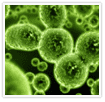 Bacillus Licheniformis: produces protease (binds amino acids into proteins) and amylase (breaks down starch into sugars). By breaking down the plants food ahead of time, your plants gets to use its energy on more important things like making better buds. Also colonies of Bacillus Lichenformis near the root zone stimulate root production, as well as secondary stem growth.
Bacillus Licheniformis: produces protease (binds amino acids into proteins) and amylase (breaks down starch into sugars). By breaking down the plants food ahead of time, your plants gets to use its energy on more important things like making better buds. Also colonies of Bacillus Lichenformis near the root zone stimulate root production, as well as secondary stem growth.
Bacillus Pumilus
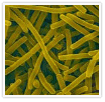 Bacillus Pumilus: acts as a fungicide by preventing the development of fungal spores on plants. It forms a physical barrier between the plant leaf and the fungal spores, and then colonizes the spores. B. pumilus also stimulates the plants own resistance system by inducing systemic acquired resistance (SAR). It also fights fungal pests such as molds, mildews, blights, rusts.
Bacillus Pumilus: acts as a fungicide by preventing the development of fungal spores on plants. It forms a physical barrier between the plant leaf and the fungal spores, and then colonizes the spores. B. pumilus also stimulates the plants own resistance system by inducing systemic acquired resistance (SAR). It also fights fungal pests such as molds, mildews, blights, rusts.
Bacillus Megaterium
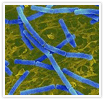 Bacillus Megaterium: Produces Penicillin amidase for constructing penicillins, enzymes for modifying corticosteroids, and several amino acid dehydrogenases. This helps plants fight any invasion of disease.
Bacillus Megaterium: Produces Penicillin amidase for constructing penicillins, enzymes for modifying corticosteroids, and several amino acid dehydrogenases. This helps plants fight any invasion of disease.
Bacillus Subtilis
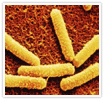 Bacillus Subtilis: is so strong that it practically cannibalizes all harmful microorganisms. It is one of the most potent and beneficial of all health-promoting and immune-stimulating bacteria. Bacillus Subtilis are able to activate nearly all systems of the plant immune defense.
Bacillus Subtilis: is so strong that it practically cannibalizes all harmful microorganisms. It is one of the most potent and beneficial of all health-promoting and immune-stimulating bacteria. Bacillus Subtilis are able to activate nearly all systems of the plant immune defense.
Trichoderma Harzianum and Trichoderma Konigii
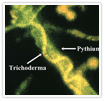 is used in foliar applications, seed treatment and soil treatment for suppression of various disease causing fungal pathogens. It has been used in the treatment of Botrytis, Fusarium and Penicillium. They parasitize other harmful fungi by literally sucking the nutrients from the pathogenic fungi hyphae. They are anaerobic fungi that only thrives in soil. T. Harzianum also helps a plant's ability to uptake nutrients by creating a "enzymatic smoothie" in the soil where it sucks the life out of it's prey. Sound Dramatic? It is because it can literally save any garden from pathogenic fungi that are quick to colonize and kill your plants. T. Konigii can also reduce the volume of harmful nematodes by attaching onto the larvae of the predator nematode, not allowing continued growth. Trichoderma it the most common fungi in the soil, so it is not necessary to add in a natural environment. But, gardens are not a natural environment, so DEM feels (as well as reasearch shows) that adding 2 of the most important trichoderma fungi is important to keep your soil and gardens beneficial and healthy.
is used in foliar applications, seed treatment and soil treatment for suppression of various disease causing fungal pathogens. It has been used in the treatment of Botrytis, Fusarium and Penicillium. They parasitize other harmful fungi by literally sucking the nutrients from the pathogenic fungi hyphae. They are anaerobic fungi that only thrives in soil. T. Harzianum also helps a plant's ability to uptake nutrients by creating a "enzymatic smoothie" in the soil where it sucks the life out of it's prey. Sound Dramatic? It is because it can literally save any garden from pathogenic fungi that are quick to colonize and kill your plants. T. Konigii can also reduce the volume of harmful nematodes by attaching onto the larvae of the predator nematode, not allowing continued growth. Trichoderma it the most common fungi in the soil, so it is not necessary to add in a natural environment. But, gardens are not a natural environment, so DEM feels (as well as reasearch shows) that adding 2 of the most important trichoderma fungi is important to keep your soil and gardens beneficial and healthy.
Endomycorrhizae
Endomycorrhizae~ "I give you carbohydrates which I am good at producing with the help of photosynthesis and you give me phosphorus". - this is a conversation between mycorrhizae and plants. Mycorrhizae is one of the first recorded examples of a biological market operating in which both partners reward fair trading rather than one partner having the advantage and exploiting the other.
Endomycorrhizae benefits plants and soils by fighting unbeneficial bacteriae/disease/ fungus/pests, it secreates oils that breakdown tightly bound nutrients( making them readily available to plants), reduces toxicity uptake, expands the root zone for pronounced nutrient absorbtion. Plants are able to uptake significantly more phosphorus and nitrogen which allow the plant to achieve ultimate yields. By adding endo-mycorrhyizae, your gardens are able to survive droughts for a longer period of time. It also colonizes and provides the best growth enhancement and the best results for greenhouse crops and herbaceous plants. From the colonized roots outwards mycelia grow into the ground acting as a kind of extension of the root system.
Glomus Intraradices
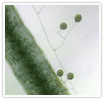
Glomus intraradices colonization peaks earlier than many of the other fungi in the Glomus genus. It has been shown to increase phosphorus uptake in multiple plants as well as improve soil aggregation due to hyphae. G. Intrardices is Arbuscular Mycorrhizae fungi is able to control nutrient uptake amounts by individual hyphae depending on differing phosphorus levels in the surrounding soil. This Endo-fungi penetrate cells of the root where they form the characteristic tree-like structured (arbuscular) organs for the exchange of sugars and nutrients with the host plant. Most of them also form bulb-like structures in and between root-cells.
Glomus Mosseae

G. mosseae is a arbuscular mycorhizal fungus and invests more energy in the root development of the host plant for effective nutrient absorption, which was fundamental to achieve for maximum yield. It is specific to mineral uptake. It finds minerals in the soil and brings them up to the root system through hyphae filaments that mimic the root structure of the host plant. Studies have been done with heavy metals and host plant uptake. The plants inoculated with G. Mosseae did not bring the heavy metals into the stem of the plant, the concentrations were kept in the root mass. It has an intelligence that protects the plant from heavy metals. A true symbiotic relationship. G. Mosseae also aides it's host plant with health through times of drought or extreme heat by bringing excess nutrients around the bulbs of the roots, giving the plant a food storage.
Glomus Etunicatum
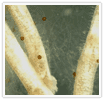 Glomus Etunicatum has shown to increase overall volume and weight of the dried harvested parts of wide leafed plants. G. Etunicatum has also shown to increase oils and resins in plants, by searching out nutrients in the soil and making them available to the plant for it's oil production. Presence of this arbuscular fungi on the host plant shows a significant ability to reduce fertilizers with no reduction in harvest. G. Etunicatum has also shown to increase levels of chlorophyll and sugars in host plants.
Glomus Etunicatum has shown to increase overall volume and weight of the dried harvested parts of wide leafed plants. G. Etunicatum has also shown to increase oils and resins in plants, by searching out nutrients in the soil and making them available to the plant for it's oil production. Presence of this arbuscular fungi on the host plant shows a significant ability to reduce fertilizers with no reduction in harvest. G. Etunicatum has also shown to increase levels of chlorophyll and sugars in host plants.
http://www.dragonflyearthmedicine.com/beneficial-bacterias-and-fungi.html
Bacillus Amyloliquefaciens

Bacillus Licheniformis

Bacillus Pumilus

Bacillus Megaterium

Bacillus Subtilis

Trichoderma Harzianum and Trichoderma Konigii

Endomycorrhizae
Endomycorrhizae~ "I give you carbohydrates which I am good at producing with the help of photosynthesis and you give me phosphorus". - this is a conversation between mycorrhizae and plants. Mycorrhizae is one of the first recorded examples of a biological market operating in which both partners reward fair trading rather than one partner having the advantage and exploiting the other.
Endomycorrhizae benefits plants and soils by fighting unbeneficial bacteriae/disease/ fungus/pests, it secreates oils that breakdown tightly bound nutrients( making them readily available to plants), reduces toxicity uptake, expands the root zone for pronounced nutrient absorbtion. Plants are able to uptake significantly more phosphorus and nitrogen which allow the plant to achieve ultimate yields. By adding endo-mycorrhyizae, your gardens are able to survive droughts for a longer period of time. It also colonizes and provides the best growth enhancement and the best results for greenhouse crops and herbaceous plants. From the colonized roots outwards mycelia grow into the ground acting as a kind of extension of the root system.
Glomus Intraradices

Glomus intraradices colonization peaks earlier than many of the other fungi in the Glomus genus. It has been shown to increase phosphorus uptake in multiple plants as well as improve soil aggregation due to hyphae. G. Intrardices is Arbuscular Mycorrhizae fungi is able to control nutrient uptake amounts by individual hyphae depending on differing phosphorus levels in the surrounding soil. This Endo-fungi penetrate cells of the root where they form the characteristic tree-like structured (arbuscular) organs for the exchange of sugars and nutrients with the host plant. Most of them also form bulb-like structures in and between root-cells.
Glomus Mosseae

G. mosseae is a arbuscular mycorhizal fungus and invests more energy in the root development of the host plant for effective nutrient absorption, which was fundamental to achieve for maximum yield. It is specific to mineral uptake. It finds minerals in the soil and brings them up to the root system through hyphae filaments that mimic the root structure of the host plant. Studies have been done with heavy metals and host plant uptake. The plants inoculated with G. Mosseae did not bring the heavy metals into the stem of the plant, the concentrations were kept in the root mass. It has an intelligence that protects the plant from heavy metals. A true symbiotic relationship. G. Mosseae also aides it's host plant with health through times of drought or extreme heat by bringing excess nutrients around the bulbs of the roots, giving the plant a food storage.
Glomus Etunicatum

http://www.dragonflyearthmedicine.com/beneficial-bacterias-and-fungi.html





